NSYC letter/State and Facility information
Attachment 8. State and Facility Information.doc
National Survey of Youth in Custody (NSYC)
NSYC letter/State and Facility information
OMB: 1121-0319
Attachment 8. State and Facility Information
8A. NSYC letter of notification
8B. Logistical information
8C. Youth roster and instructions
8D. Administrative record form and instructions
8A. Letter of notification
<DATE>
<FACILITY NAME>
<ADDRESS>
<CITY, STATE, ZIP>
Dear <NAME>,
I am writing to announce the start of national implementation of the youth self-report data collections, as mandated by the Prison Rape Elimination Act (P.L. 108-79). Each year the Bureau of Justice Statistics (BJS) must carryout a comprehensive statistical report and analysis of the incidence and effects of prison rape. BJS is required to sample “not less than 10 percent” of correctional facilities nationwide, to submit a report that ranks each sampled facility based on the incidence of prison rape, and to list any facilities that fail to cooperate with the survey.
After an extensive effort, involving input from juvenile justice administrators, practitioners, and researchers, BJS and Westat have successfully developed a questionnaire and related collection protocols. A large scale test of these procedures was completed in early 2007. The Office of Management and Budget has reviewed the survey and has given BJS approval to begin implementation.
The attached document lists the facilities under your jurisdiction that have been randomly selected for the first year of implementation. The document also includes all privately operated facilities in your state that were selected. The corporate office of these private facilities will be notified directly. I have enclosed a brochure that provides an overview of the study and an information sheet that describes the roles and responsibilities of the facility coordinator.
This letter is also being sent to ___, who was designated by your office as the primary liaison for the survey. Westat, BJS’s data collection agent for the survey, will be contacting the liaison in the next few weeks to coordinate data collection. Please call ___ at (xxx) xxx-xxxx if you wish to designate a different contact person.
I would like to thank you for assistance in conducting the survey. Please feel free to call me at (202) 616-3277 or Westat staff at (xxx) xxx-xxxx, if you have any questions about the survey. Thank you for being a part of the National Survey of Youth in Custody.
Sincerely,
Allen J. Beck
Principal Deputy Director
8B. Logistical information
T
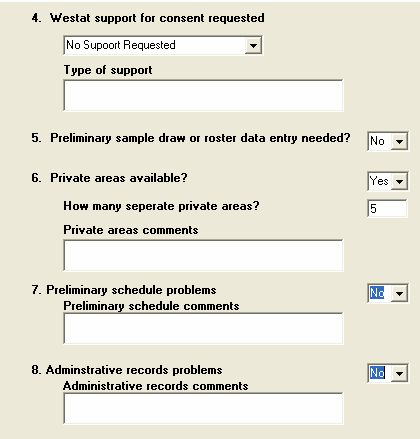
 he
following screenshots are of the Facility Recruitment Tracking System
(FRTS). During a series of brief phone calls, recruiters will
collect information about facility characteristics and logistics.
he
following screenshots are of the Facility Recruitment Tracking System
(FRTS). During a series of brief phone calls, recruiters will
collect information about facility characteristics and logistics.
Consent and Counseling Arrangements
Facility Characteristics
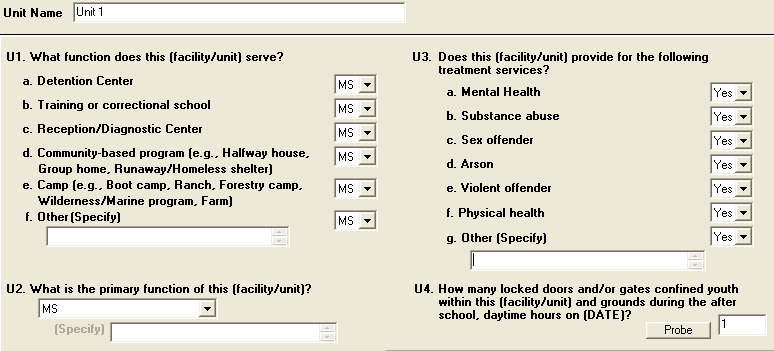
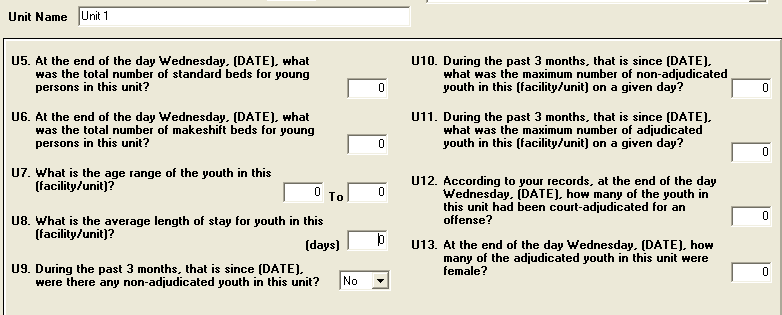
L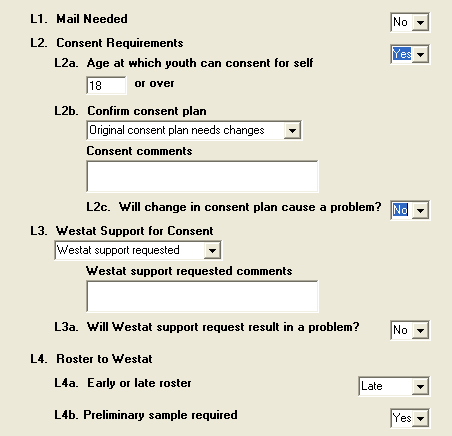
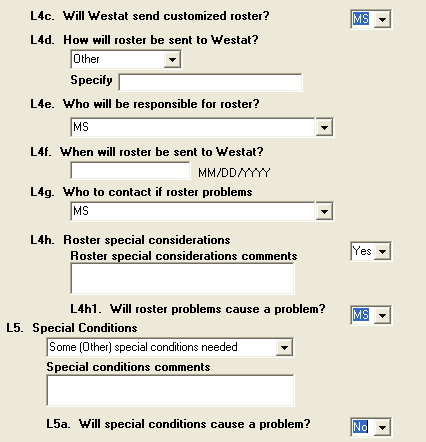 ogistics
ogistics
Logistics 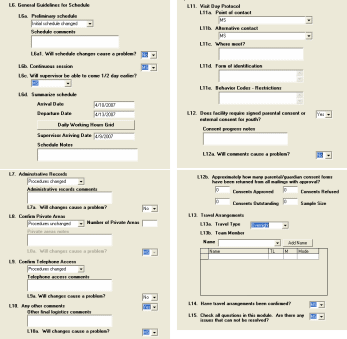 (continued)
(continued)
8C. Youth Roster and Instructions
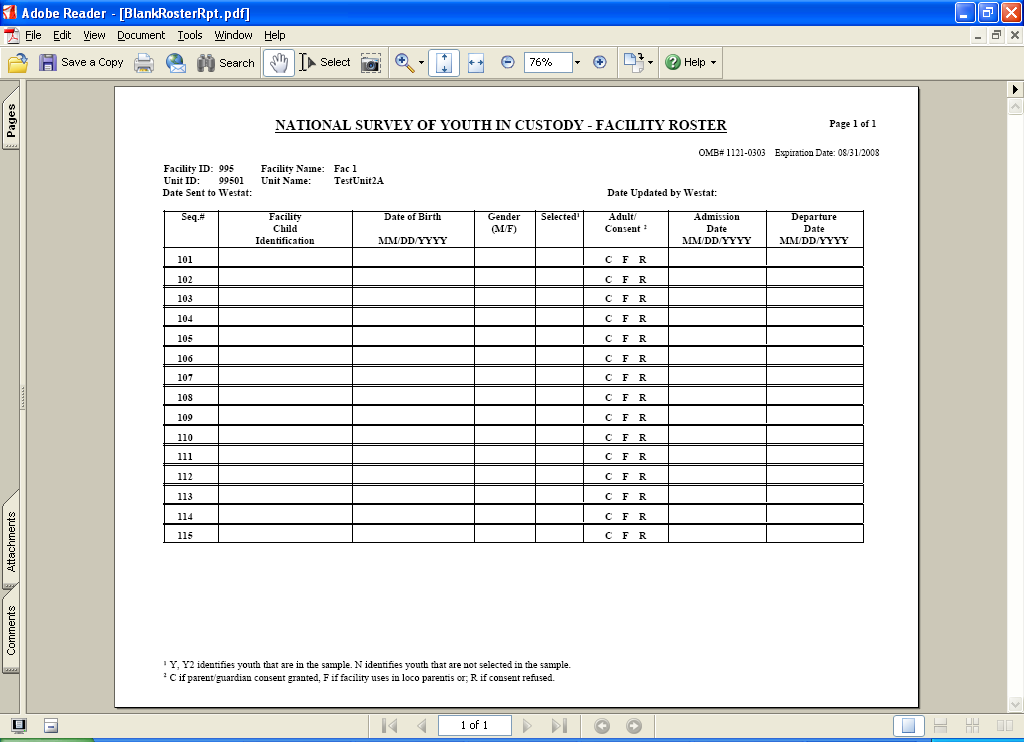
ROSTER INSTRUCTIONS
The roster is used to sample eligible youth in this facility for the National Survey of Youth in Custody.
Complete a separate roster for each sleeping unit in this facility that houses adjudicated youth.
Include on the roster:
All youth under 21 in the unit who are court-adjudicated for an offense.1
All youth 21 and older regardless of status.
All youth who are adjudicated or 21 or older and are away temporarily.
Do NOT include staff.
If you make a mistake and list a youth in error, simply line through the name, and continue on the next line. DO NOT RENUMBER THE LINES.
Column Descriptions.
Column A – Sequence number used to match the left side of the roster to the right side. Do not change the information shown in this column.
Column B – Facility identification number. Assign any number that you can use to identify the youth, such as a case identification number.
Column C – Name of youth Record the name that you will use to identify the youth. Do not provide this information to Westat.
Column D – Sequence number. (Same as Column A.)
Column E – Facility identification number (Same as Column B.)
After you receive the updated roster, you will know which youth have been selected. You can use that information to obtain parent/guardian consent and to complete the remaining columns on the roster.
Column F – Date of birth. Please record in a numerical mode with a two digit month and date, and a four digit year; MM/DD/YYYY, e.g., 10/24/1991.
Column G – Gender of youth. Record M or F.
Column H – This column indicates whether or not the youth was selected to be part of the study. It will be completed by Westat and returned to you within a week.
Once You Have Completed The Roster, Detach Columns A, B, And C And
Send It To Westat At The Address Below.
<<NAME AND ADDRESS>>
Make a copy of the right side of the roster to send to
Westat (Columns D – L). You can fold over the left side
(Columns A – C) to keep the roster intact.
INSTRUCTIONS FOR UPDATING THE ROSTER AFTER THE INITIAL SAMPLE IS SELECTED.
The roster will be returned to you within a week in the same order as the original. You will know which youth have been selected by the indication in Col. H. You can use that information to obtain parent/guardian consent. Youth who have reached the age of majority in your state are able to consent for themselves once the researcher has explained the study to them.
Columns I and J will be completed by you after Westat returns the roster to you.
The date you send the roster to Westat will become the effective date of the sample. Westat will generate a new roster based on the information you send. The new roster will look like the only one and be printed in the same order as the original. It will indicate which residents have been selected for the sample in Column H.
Column H – Adult/Consent
The roster will be returned to you with the word “Adult” pinted in this column for youths who have reached the age of self consent in your state as of the expected start date of data collection.
Circle “C” if the parent/guardian has consented.
Circle “R” if the parent/guardian has refused.
Column I – Date of departure. If the youth left the facility, please indicate the date. Please record the month, day, and year; use four digits to indicate year.
Column J – Date of admission. This column will be filled in with the date of admission you provided for the most recent offense.
Finally, if a newcomer (adjudicated or 21 year old or older) arrives in the unit, icomplete the next empty row on the roster for him or her with the information described above. If needed, please attempt to obtain parent/guardian consent for these youth on the day they arrive to the unit or visitation day.
If someone departs from the facility, please simply line through that person’s line and indicate the departure date. You only need to do so for those marked as sampled.
EXAMPLE OF A BLANK ROSTER
|
||||||||||
FACILITY KEEP THIS PART OF THE ROSTER |
SEND THIS PART OF THE ROSTER TO WESTAT |
|||||||||
|
||||||||||
Facility Name/ID |
Facility Name/ID: -Page 1 of __________ |
|||||||||
Unit Name/ID |
Unit Name/ID: |
|||||||||
|
Date Sent to Westat: Effective Date of Roster |
|||||||||
|
||||||||||
A. Seq.# |
B. Facility Identification # |
C. Name |
D. Seq.# |
E. Facility Identification #
|
F. Date of Birth MM/DD/YYYY MM/DD/YYYY |
G. Gender (M/F) |
H. Selected (Y/N) |
I. * Consent |
J. Departure Date
MM/DD/YYYY |
K. Admission Date
MM/DD/YYYY |
101 |
|
|
101 |
|
|
|
|
A C R |
|
|
102 |
|
|
102 |
|
|
|
|
A C R |
|
|
103 |
|
|
103 |
|
|
|
|
A C R |
|
|
104 |
|
|
104 |
|
|
|
|
A C R |
|
|
105 |
|
|
105 |
|
|
|
|
A C R |
|
|
106 |
|
|
106 |
|
|
|
|
A C R |
|
|
107 |
|
|
107 |
|
|
|
|
A C R |
|
|
108 |
|
|
108 |
|
|
|
|
A C R |
|
|
109 |
|
|
109 |
|
|
|
|
A C R |
|
|
110 |
|
|
110 |
|
|
|
|
A C R |
|
|
111 |
|
|
111 |
|
|
|
|
A C R |
|
|
112 |
|
|
112 |
|
|
|
|
A C R |
|
|
113 |
|
|
113 |
|
|
|
|
A C R |
|
|
114 |
|
|
114 |
|
|
|
|
A C R |
|
|
115 |
|
|
115 |
|
|
|
|
A C R |
|
|
Col L - A = Adult
C = Consent Received by Parent/Guardian
R = Parent/Guardian or Facility Refused.
8D Administrative Record Form and Instructions
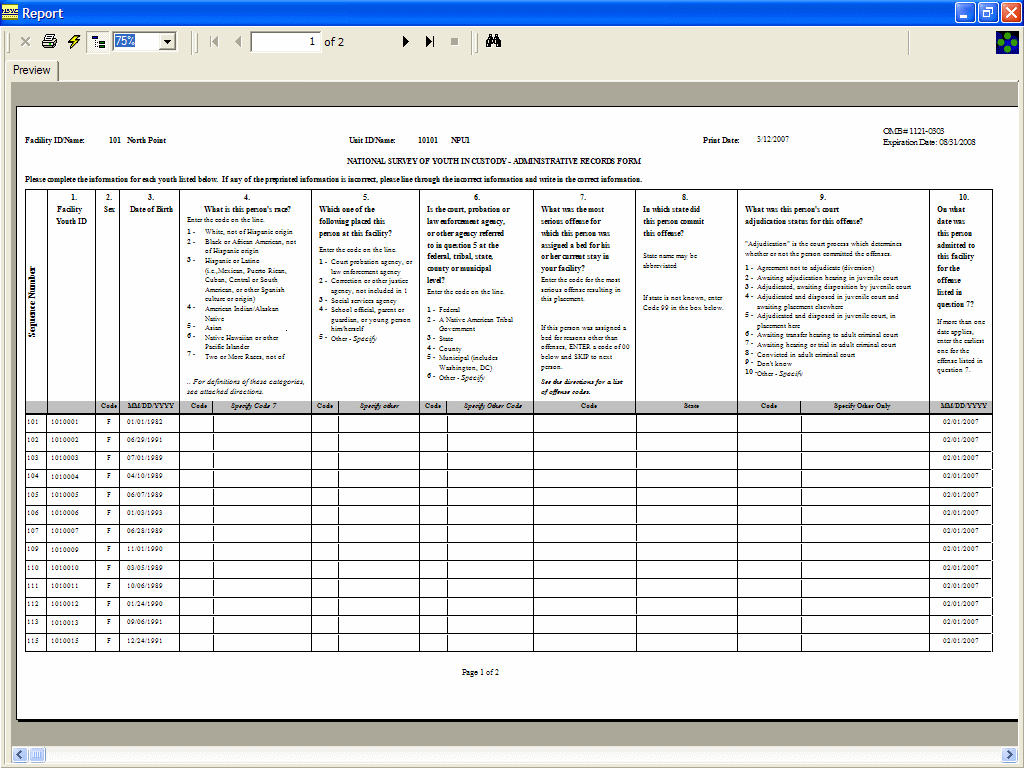
NATIONAL STUDY OF YOUTH IN CUSTODY
Directions for Completing the Administrative Records Form
Please answer the questions on the Administrative Records Form for all potential participants, whether or not they completed the survey. This information provides the researchers with the data they need to review the statistical procedures for the study.
Youth listed on the form include all those who were selected into the sample from the NSYC roster. It also includes the other roster information you provided to Westat – unit designator, facility supplied ID. gender, date of birth, date of admission The Youth ID number that appears in the second column of the form matches the ID number that was assigned by your facility on the roster.
Please choose one of the following ways to record this information:
Write the remaining pieces of information on the attached Administrative Records Form(s). These include items 4 – 9. Please give the completed form(s) to the field supervisor before the end of the visit. KEEP A COPY OF THE DATA YOU SUBMIT.
OR
Provide a data file which conforms to the Administrative Records Form record layout. The acceptable formats are: Excel spreadsheet, a comma delimited ASCII file with double quotes surrounding each element, or a positional ASCII file with the data layout schema.
Youth facility ID’s must not contain single quotes ( ‘ ), double quotes ( “ ), commas ( , ) or vertical bars ( | ) and may not exceed 25 characters. Birthdates must be in the format mm/dd/yyyy or mm-dd-yyyy.
Please send the file to:
National Survey of Youth in Custody
Westat, RW 2634
1650 Research Blvd.
Rockville, MD 20850
OR
Email the file to:
KEEP A COPY OF THE DATA YOU SUBMIT.
GENERAL INFORMATION ABOUT OFFENSES
An offense is anything that ILLEGAL IN YOUR STATE for underage
persons but not for adults. Examples include running away, truancy,
incorrigibility, curfew violation, and underage liquor violations.
This includes those CHINS (Children in Need of Services) and PINS
(Persons in Need of Services) who are at the facility because
of an offense.
Any offense ADJUDICATED in juvenile or criminal court,
including a probation or parole violation.
Use the OFFENSE DEFINITIONS and OFFENSE CODES on Page 2 and 3 to answer Q. 7
OFFENSE DEFINITIONS
Alcohol or drugs, driving under the influence of Driving or operating a motor vehicle while under the influence of alcohol, a drug or controlled substance. Code 42.
Alcohol: underage use, possession, or consumption of - Possession, use, or consumption of alcohol by a minor. Code 51.
Arson - Actual or attempted intentional damaging or destroying of property by fire or explosion, without the owner's consent. Code 15.
Assault - An actual, attempted, or threatened physical attack on a person that 1) involves the use of a weapon or 2) causes serious physical harm. Include attempted murder. Code 13
Auto theft, unauthorized use of auto, joyriding Actual or attempted unauthorized taking or use of a motor vehicle, intending to deprive the owner of it temporarily or permanently. Include joyriding and grand theft auto. Code 17.
Burglary, breaking and entering, household larceny - Actual or attempted unlawful entry of a building, structure, or vehicle with intent to commit larceny or another crime. Code 16.
Curfew violation - Violation of an ordinance forbidding persons below a certain age from being in public places during set hours. Code 53.
Drugs or narcotics, possession - Actual or attempted purchase, possession or use of any illegal drug or substance, excluding alcohol. Code 24.
Drugs or narcotics, trafficking - Actual or attempted making, selling, or distributing of a controlled or illegal drug or substance. Code 18.
Incorrigible, ungovernable - Being beyond the control of parents, guardians, or custodians. Code only if this is considered an offense in your state. Code 52.
Kidnapping - Actual or attempted unlawful transportation or confinement of a person without his/her consent (or, if a minor, consent of a guardian). Code 12.
Murder/manslaughter/negligent homicide Causing the death of a person without legal justification. Code 10.
Non-violent sex offense, statutory rape - Actual or attempted offenses with a sexual element, without violence. Include consensual sex with an underaged person, prostitution, solicitation, indecent exposure, pornography, and obscenity. Code 43. For sexual abuse by a minor against another minor - See Violent sexual assault.
Obstruction of justice - Any act that intentionally impedes the enforcement of a law or court order. Examples: Escape from confinement, contempt of court, perjury, failing to report a crime, nonviolently resisting arrest, and bribery. Code 45. See Probation/parole violation.
Other drug-related offense - Use this Code if the drug offense is not specifically listed on the offense Codes or definitions. Examples include: possession of drug paraphernalia, visiting a place where drugs are found, etc. Code 26.
Other offense that is illegal for underage persons only - Use this Code if the drug offense is not illegal for adults and is not specifically listed on the offense Codes or definitions. Examples include: underage smoking, unruliness in school, etc. Code 59.
Other person offense - Use this Code if the person offense is not specifically listed on the offense Codes or definitions. Examples include: harassment, coercion, reckless endangerment, etc. Code 21.
Other property offense - Use this Code if the property offense is not specifically listed on the offense Codes or definitions. Examples include: trespassing, selling stolen property, possession of burglar's tools, fraud, etc. Code 23.
Other public order offense - Use this Code if the public order offense is not specifically listed on the offense Codes or definitions. Examples include: cruelty to animals, disorderly conduct, traffic offenses, etc. Code 49.
Probation or parole violation, violation of valid court order - Acts that disobey or go against the conditions of probation or parole. Examples: failure to participate in a specific program, failure to appear for drug tests or meetings, and failure to pay restitution. Code 61.
Property damage, vandalism - Actual or attempted damaging or destroying of property of a person or public property. Code 22. For destroying or damaging by fire or explosion - See Arson.
Robbery - Actual or attempted unlawful taking of property in the direct possession of a person by force or threat of force. Include purse snatching with force and carjacking. Code 14. For purse snatching without force - See Theft/non-household larceny.
Running away - Leaving the custody and home of parents or guardians without permission and failing to return within a reasonable length of time. Code only if this is considered an offense in the state in which it occurred. Code 50. For running away from a facility - See Obstruction of justice.
Theft, non-household larceny - Actual or attempted taking of property (other than an auto) from a person without force or deceit. Include shoplifting, pickpocketing, and purse snatching without force. Code 20.
For purse snatching with force - See Robbery.
For theft using deceit - See Other property offense.
For household larceny - See Burglary, breaking and entering, household larceny.
Truancy - Violation of a compulsory school attendance law. Code only if this is considered an offense in your state. Code 53.
Violent sexual assault including forcible rape Actual or attempted sexual intercourse or sexual assaults against a person against her/his will by force or threat of force. Includes incest, sodomy, and sexual abuse by a minor against another minor. Code 11. See also Non-violent sex offense, statutory rape.
Weapons-related offenses - Actual or attempted illegal sale, distribution, manufacture, alteration, transportation, possession, or use of a deadly or dangerous weapon or accessory. Code 40.
list of offense codes
Drug-Related Offenses or Offenses Against Persons or Property
10 Murder, manslaughter, negligent homicide (killing someone)
11 Violent sexual assualt including forcible rape
(having or trying to have sexual relations with someone against their will)
12 Kidnapping someone
13 Assault (attacking or hitting someone)
14 Robbery (using force or threat to get money or things from someone)
15 Arson (purposely setting fire to a house, building, car or other property)
16 Burglary, breaking and entering (breaking into a locked building to steal something)
17 Auto theft (stealing or trying to steal a car or other motor vehicle)
18 Drugs or narcotics, trafficking (selling drugs)
19 Unauthorized use of auto, joyriding
(taking a car or other motorized vehicle for a drive without the owner's permission)
20 Theft, larceny (stealing or trying to steal money or things)
21 Other person offense (please specify)
22 Property damage, vandalism
(purposely damaging or destroying property that did not belong to the youth)
23 Other property offense (please specify)
24 Drugs or narcotics, possession (using drugs or having drugs in the youth's possession)
25 Testing positive for using drugs
26 Other drug-related offense (please specify)
Offenses Against the Public Order
40 Weapons-related offenses (carrying a weapon)
41 Prostitution (being paid for having sexual relations with someone)
42 Driving a car under the influence of alcohol or drugs
43 Non-violent sex offense, statutory rape
44 Being drunk in public
45 Obstruction of justice
49 Other public order offense (please specify)
Possible Offenses for Underage Persons Only
50 Running away
51 Underage use, possession or consumption of alcohol
52 Incorrigible, ungovernable
53 Curfew violation
53 Truancy (skipping school without an excuse)
59 Other offense that is illegal for underage persons only (please specify)
Probation or Parole Violation
60 Violating house arrest or electronic monitoring
61 Other probation or parole violation (please specify)
Unknown Offenses
99 Unknown offense
RACIAL CATEGORIES
The Federal Government uses the following definitions for the various racial categories.
1 White, not of Hispanic origin – A person having origins in any of the original peoples of Europe, the Middle East or North Africa.
2 Black or African American, not of Hispanic origin – A person having origins in any of the black racial groups of Africa.
3 Hispanic or Latino (i.e., Mexican, Puerto Rican, Cuban, Central or South American, or other Spanish culture or origin), regardless of race – A person of Cuban, Mexican, Puerto Rican, South or Central American or other Spanish culture or origin, regardless of race.
4 American Indian/ Alaska Native, not of Hispanic origin – A person having origins in any of the original peoples of North America and South American (including Central America) and who maintains tribal affiliations or community attachment.
5 Asian, not of Hispanic origin – A person having origins in any of the original peoples of the Far East, Southeast Asia, or the Indian subcontinent, including, for example, Cambodia, China, India, Japan, Korea, Malaysia, Pakistan, the Phillippine Islands, Thailand, and Vietnam.
6 Native Hawaiian or other Pacific Islander, not of Hispanic origin – A person having origins in any of the original peoples of Hawaii, Guam, Samoa or other Pacific Islands.
7 Two or More Races, not of Hispanic origin – Refers to combinations of two or more of the following race categories: White, Black or African American, American Indian/Alaska Native, Asian, Native Hawaiian or other Pacific Islander. In cases of Hispanic origin, regardless of race(s), mark “Hispanic or Latino”
1 Court adjudicated for an offense means any behavior that is illegal in your state for underage persons but not adults or illegal for both underage persons and adults.
| File Type | application/msword |
| File Title | Attachment 10 |
| Author | John Hartge |
| Last Modified By | harrisop |
| File Modified | 2007-09-18 |
| File Created | 2007-09-06 |
© 2026 OMB.report | Privacy Policy